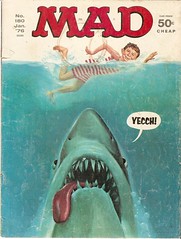The last few years have been filled with the predictions of the “great newspaper demise” — and fears that the business model used by most magazines is unsustainable in today’s digital world. So I pick up on a theme seen here before in the pages of the Marketing Partners’ blog, specifically that I hope that the digital revolution isn’t robbing us of a few simple pleasures.
In the Beginning There Was MAD
My love of magazines started with MAD Magazine (remember Alfred E. Neuman and SPY vs. SPY?) in the waiting room of my orthodontist. Full disclosure: I had a huge overbite and large gap between my two front teeth, so I spent a lot of time at the orthodontist. About this same time, (you know — those very attractive and carefree days of middle school/junior high?) I was also consuming large amounts of data from the pages of Tiger Beat. OK — so it wasn’t so much data I was consuming, it was more photographs of my “crush du jour”. These torn out photos most often wound up on the walls of my room, before being quickly replaced by the next “crush du jour.”
As I grew older, about the time I turned 15, my taste matured to Seventeen. (I thought I was really sophisticated to be reading Seventeen at age 15, by the way. Little did I realize 15 is precisely the demographic they were targeting…) On rare occasions I got an elicit peek at “Cosmopolitan” — usually in the really slow grocery store checkout lanes with my mother while she was talking to yet another acquaintance.
Magazines in the Real World
I was not much of a devotee of the magazine while I was in college. (Too busy ordering pizzas — oh, and studying — then…) But once out here in the real world, magazines have continued to mirror my age. One of the first joys of getting engaged was to finally to buy up an entire rack of hugely expensive bridal magazines — followed five years later by purchasing Parents. But shortly after my first child, the Internet plowed into our culture and things have not been quite the same for me and my magazines. My subscriptions to People and Newsweek have expired.
Now the only time I get to truly savor a magazine is in the hair salon. I am afraid my stylist gets a little hurt that I don’t chat with her more — but there is something about sitting in the salon chair for hours (yes, my hair appointments are hours) that is just perfect for reading magazines. I don’t scan the pages for bridesmaids dresses or tips for avoiding ear infections anymore, but I still love the advertisements for jewelry and fashion. And movie and book reviews. Self improvement. Exercise tips. Makeovers. Oprah. And I get the rare opportunity to turn the pages.
The Internet and iPad and Kindle have turned reading into a digital exercise now (I’d love to know if this has created a boom in the field of optometry), so there are only virtual pages to turn. But the ads and photos don’t offer me the same joy on the screen as they do on the page. Am I alone?
Long Live Magazines
The experts out there have observed that the magazines that are still viable are the ones that have changed with the times — developing content for the web, developing content for the printed page. And using social media to hook us into either medium, as this recent Guardian article by Lisa Mclean observes. Mclean’s piece also supports my theory that some of us will never be able abandon the printed medium.
Magazines are like a utility service to me: as I age I am drawn to the relevant and timely information that only crafty and savvy editors and advertisers can compile. I don’t mind if they reach me via social media (although they seem to have lots of room for improvement here, according to this story about the 2011 American Magazine Conference). I am counting on them to find me, keep up with me, hook me — their target demographic — until my eyes can no longer enjoy the photographs and my hands can no longer turn the page. Long live magazines for people of all ages.



